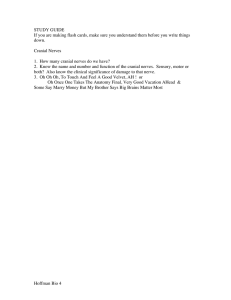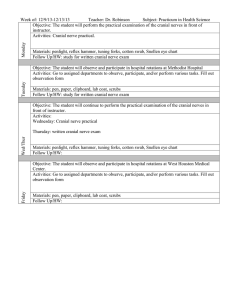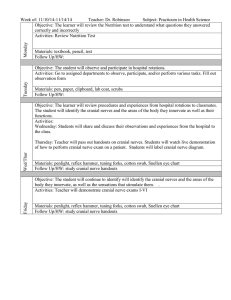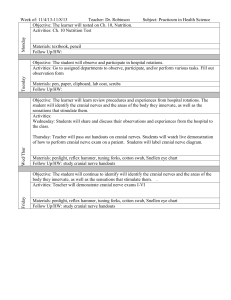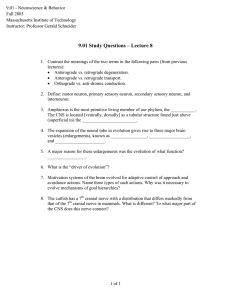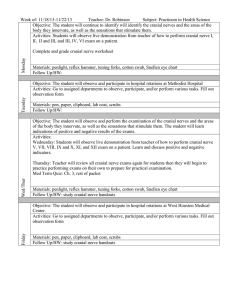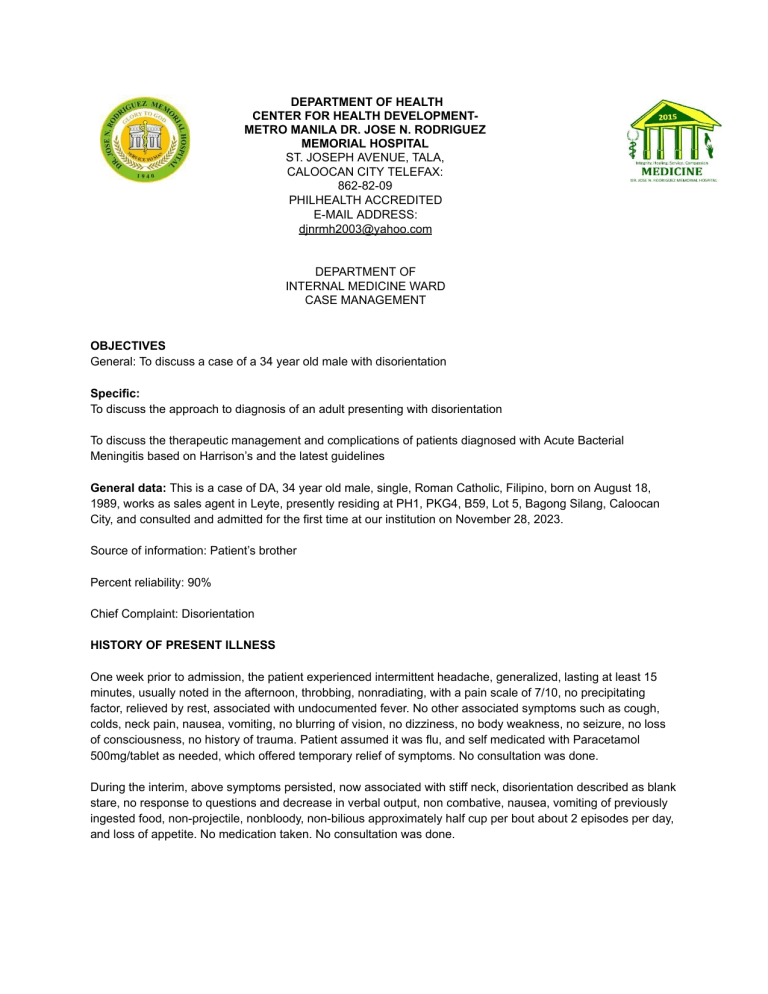
DEPARTMENT OF HEALTH CENTER FOR HEALTH DEVELOPMENTMETRO MANILA DR. JOSE N. RODRIGUEZ MEMORIAL HOSPITAL ST. JOSEPH AVENUE, TALA, CALOOCAN CITY TELEFAX: 862-82-09 PHILHEALTH ACCREDITED E-MAIL ADDRESS: djnrmh2003@yahoo.com DEPARTMENT OF INTERNAL MEDICINE WARD CASE MANAGEMENT OBJECTIVES General: To discuss a case of a 34 year old male with disorientation Specific: To discuss the approach to diagnosis of an adult presenting with disorientation To discuss the therapeutic management and complications of patients diagnosed with Acute Bacterial Meningitis based on Harrison’s and the latest guidelines General data: This is a case of DA, 34 year old male, single, Roman Catholic, Filipino, born on August 18, 1989, works as sales agent in Leyte, presently residing at PH1, PKG4, B59, Lot 5, Bagong Silang, Caloocan City, and consulted and admitted for the first time at our institution on November 28, 2023. Source of information: Patient’s brother Percent reliability: 90% Chief Complaint: Disorientation HISTORY OF PRESENT ILLNESS One week prior to admission, the patient experienced intermittent headache, generalized, lasting at least 15 minutes, usually noted in the afternoon, throbbing, nonradiating, with a pain scale of 7/10, no precipitating factor, relieved by rest, associated with undocumented fever. No other associated symptoms such as cough, colds, neck pain, nausea, vomiting, no blurring of vision, no dizziness, no body weakness, no seizure, no loss of consciousness, no history of trauma. Patient assumed it was flu, and self medicated with Paracetamol 500mg/tablet as needed, which offered temporary relief of symptoms. No consultation was done. During the interim, above symptoms persisted, now associated with stiff neck, disorientation described as blank stare, no response to questions and decrease in verbal output, non combative, nausea, vomiting of previously ingested food, non-projectile, nonbloody, non-bilious approximately half cup per bout about 2 episodes per day, and loss of appetite. No medication taken. No consultation was done. 1 day prior to admission, the patient was found by his workmate collapsed on his bed, still disoriented, with generalized body weakness noted. Siblings were informed about the patient’s condition, and later on decided to transfer the patient to Manila for further management, hence consultation and admission. Past Medical History: The patient is non-hypertensive, non-diabetic and non-asthmatic, with no heart, kidney, liver and thyroid diseases. No history of cerebrovascular disease and malignancy. No previous history of tuberculosis infection. No previous surgeries, hospitalizations, and blood transfusion. No known allergy to food and medications. Patient is fully COVID 19 vaccinated with 2 doses of Sinovac and 1 booster. Family History: Patient’s mother is already deceased due to unknown cause and unrecalled year, with no known heredo-familial disease. His father is alive and apparently well. He is the 3rd of 4 siblings, the 2nd of which is known asthmatic. No other known heredo-familial diseases such as hypertension, cancer, cerebrovascular diseases, blood disorders, kidney and liver diseases, hypersensitivity and immunologic disorders. Personal and Social History: The patient is a nonsmoker, an occasional alcoholic beverage drinker, last drink was 4 months ago, and denies any history of illicit drug use. He works as a sales agent, and stays in a well lit well ventilated bungalow house with his workmate. Their water source is from Nawasa, drinking water is mineral water, garbage is collected once a week. The patient prefers rice, is fond of eating vegetables and fish, and eats 3 meals a day. He is homosexual, coitarche was 17 years old, and had 2 male sexual partners since, both insertive and receptive, unprotected, who he met on a dating app. REVIEW OF SYSTEMS Constitutional symptoms: (+) undocumented weight loss (-) fatigue, (-) chills Skin: (+) itchiness, (+) rashes, (-) excessive dryness or sweating, (-) cyanosis, (-) pallor, (-) erythema Eyes: (-) pain, (+) blurring of vision, (-) double vision, (-) excessive lacrimation, (-) photophobia Ears: (-) earache, (-) deafness, (-) tinnitus, (-) ear discharge Nose and Sinuses: (-) changes in smell, (-) nose bleeding, (-) nasal obstruction, (-) nasal discharge, (-) pain over paranasal sinuses Mouth and Throat: (-) toothache, (-) gum bleeding, (-) disturbance in taste, (-) sore throat, (-) hoarseness Neck: (-) pain, (-) limitation of movement, (-) mass Respiratory:(-) cough (-) wheezing (-) cyanosis, (-) hemoptysis Cardiovascular: (-) substernal pain, (-) palpitations,(-) paroxysmal nocturnal dyspnea, (-) syncope, (-) easy fatigability, (-) orthopnea Gastrointestinal: (-) abdominal pain, (-) dysphagia, (-) diarrhea, (-) constipation, (-) hematemesis, (-) melena, (-) hematochezia, (-) regurgitation Genitourinary: (-) dysuria, (-) urinary frequency, (-) urgency, (-) hesitancy, (-} polyuria, (-) hematuria, (-) incontinence, (-) genital pruritus, (-) urethral discharge Hematologic: (-) bleeding tendency, (-) pallor, (-) easy bruising Endocrine: (-) intolerance to heat and cold, (-) polydipsia PHYSICAL EXAMINATION General survey: Patient is awake, disoriented, not in cardiorespiratory distress, weak-looking, unkempt Vital signs: BP 120/80 HR 77 RR 21 T 38.8 O2SAT 99% at RA HEIGHT 165 cm WEIGHT 50 kg BMI 18.4 (Normal) HEENT Head: Hair is black in color, well-distributed. Head is normocephalic, symmetrical, no masses, lesions, no tenderness. Temporal arteries are not visible but palpable with equal pulsations. Face: Face is ovoid, symmetrical, no lesions, masses nor discolorations. Eyes: Eyebrows are black and evenly distributed with no lesions. No edema, erythema, lesions, masses, no ptosis seen on bilateral eyelids. Eyelashes are thin and evenly distributed, no matting, no discharge. Anicteric sclera, pink palpebral conjunctiva. Nose: Symmetrical, with bilaterally patent vestibules. The nasal septum is at the midline, without deviations nor perforations. No nasopharyngeal congestion, no discharge. The maxillary and frontal sinuses are non-tender. Ears: Symmetrical auricles, brown, no lesions, no masses, no scars, non tender. Mouth and oral cavity: Lips are moist, symmetrical, no lesions. The tongue is at the midline, pink, moist, no plaques, no ulcers. Neck: Neck is supple and at the midline, no deformities, no lesions, no masses, no visible vein engorgement, no palpable lymph nodes, with nuchal rigidity Chest and Lungs: Chest is fair in color, no cyanosis, with no visible mass nor lesions, no chest wall deformities, symmetrical chest expansion, no retractions, no lagging, normal tactile fremitus, resonant, vesicular breath sounds on bilateral lung field, no adventitious sounds, no wheezing, no crackles Heart: Adynamic precordium, apex beat at 5th intercostal space at left midclavicular line, no thrills, no heaves, no lifts. Normal rate, regular rhythm, no audible murmur. Abdomen: Abdomen is fair, flat, inverted umbilicus, no scars, no lesions, no visible veins, no discolorations. On auscultation normoactive bowel sounds. On percussion, tympanitic on all quadrants. On palpation, no tenderness, no masses, no organomegaly. Extremities: No edema, no gross deformities, full and equal pulses. Skin: Well-defined hyperpigmented papules topped with some scales on bilateral upper extremities. Pink nail beds with capillary refill time of less than 2 seconds. NEUROLOGICAL EXAMINATION CEREBRAL FUNCTION: The patient is awake, confused, not oriented to time, place or person, does not appropriately respond to questions and cannot follow commands. CRANIAL NERVE FUNCTION: Cranial Nerve I: Not assessed Cranial Nerve II: Pupils 2-3 mm, equally reactive to light. Cranial Nerve Ill, IV, VI: Positive doll’s reflex Cranial Nerve V: Positive corneal reflex, motor cannot be assessed Cranial Nerve VII: No facial asymmetry Cranial Nerve VIll: Intact gross hearing Cranial Nerve IX,X: Uvula at midline, intact gag reflex Cranial Nerve XI: Cannot be assessed Cranial XII: Cannot be assessed CEREBELLAR FUNCTION: Dysmetria and dysdiadochokinesia cannot be fully assessed Reflexes: 2+ on all extremities; (-) Babinski Meningeal Signs: (+) Nuchal Rigidity, (+) Kernig’s, (+) Brudzinski's MOTOR FUNCTION SENSORY FUNCTION INITIAL WORKING IMPRESSION To Consider Acute Bacterial Meningitis
